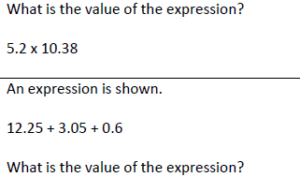Add, subtract, multiply, and divide decimals to hundredths, using concrete models or drawings and strategies based on place value, properties of operations, and/or the relationship between addition and subtraction; relate the strategy to a written method and explain the reasoning used.
[divider] [/divider]
Students are able to…
- Connect previous experiences with the meaning of addition, subtraction, multiplication and division of whole numbers to addition, subtraction, multiplication and division of decimal numbers using models and place value structure.
- Check reasonableness of their answer using strategies for estimation.
- Explain their reasoning using models, pictures, words, and numbers.
- Use precise language when discussing and justifying their thinking.
Students are able to…because teachers:
- Provide opportunities for students to use base-ten blocks and pictures to model addition/subtraction/multiplication/division of decimals.
- Model the use of precise place value language.
- Facilitate exploration of strategies and connect the strategies through discussion.
- Provide opportunities for students to explore with different strategies and have meaningful discussions about efficiency and reasonableness.
[divider] [/divider]
Questions to ask students:
- Ask students how base ten blocks help when adding/subtracting/multiplying/dividing decimals.
- Ask students how place value connects to their strategy.
- Ask students to describe place value patterns with multiplication.
- Sample answer that indicates understanding: When I multiply tenths by tenths, the product is in the hundredths. When I multiply tenths by hundredths, the product is in the thousandths.
- Ask a student that is connecting the standard algorithm for addition/subtraction of whole numbers to work with decimals why it is important that they line up the place values of the digits.
- Sample answer that indicates understanding: I must line up the place values because tenths need to be added to tenths, hundredths with hundredths, ones with ones, etc.
- Sample answer that indicates an incomplete understanding or misconception: It is the first step to line up the decimal point.
[divider] [/divider]
FSA Notes:
Cognitive Complexity Level: Level 2- Basic Application of Skills & Concepts
Achievement Level Descriptors:
Level 2: adds and subtracts decimals to the hundredths place, using concrete models or drawings and strategies based on place value, properties of operations, and/or the relationship between addition and subtraction
Level 3: multiplies and divides decimals to the hundredths place, using concrete models or drawings and strategies based on place value, properties of operations, and/or the relationship between addition and subtraction; relates the
strategy to a written method and explains the reasoning used
Level 4: adds, subtracts, multiplies, and divides decimals to the hundredths place to solve multistep problems
Level 5: determines the error in the computation of a problem involving decimals, and justifies the reasoning
Assessment Limits:
Items may only use factors that result in decimal solutions to the thousandths place (e.g., multiplying tenths by hundredths).
Items may not include multiple different operations within the same expression(e.g., 21 + 0.34 × 8.55).
Expressions may have up to two procedural steps of the same operation.
Context: Allowable
[divider] [/divider]
Additional Resources:
Additional in depth content knowledge:
http://www.katm.org/flipbooks/5%20FlipBook%20Final%20CCSS%202014.pdf#page=36
Video: Add decimals using base ten blocks
Sample Formative Assessment Task: (Click to enlarge task image)

Resources/Tasks to Support Your Child at Home:
Addition of Decimals:
- Real World Situation: Sahara ran 2.5 miles on Tuesday, and 2.8 miles on Thursday. How many miles did she run that week?
- Record 2 or 3 prices of items from the grocery store (use the receipt, or price tags on items). Have your child find the sum of the three products?
- Khan Academy Practice Problems for addition and Subtraction
Subtraction of Decimals
- Real World Situation: Derek had $1.36 to spend at the store. If he bought a candy bar for $1.03, how much did he have left over?
- Record 2 or 3 prices of items from the grocery store (use the receipt, or price tags on items). Have your child find the difference between each items?
- Khan Academy Practice Problems for addition and Subtraction
Multiplication of Decimals:
- eLab – Multiplying decimals and whole numbers http://tinyurl.com/5g7gjr
- Real Word Situation: Tina’s cat weighs 2.6 kilograms. Her dog weighs 4 times as much as her cat. How much does her dog weigh in kilograms?
- Real Word Situation: The distance from the park to the grocery store is 0.9 mile. Scott runs 6 tenths of that distance and walks the rest of the way. How far does Scott run from the park to the grocery store?
- One cup of cooked zucchini has 1.8 grams of protein. How much protein is in 0.4 cup of zucchini?
Division of Decimals:
- Dividing Decimal Dividends by Whole Numbers (video) – http://tinyurl.com/hght6eg
- Divide Decimals by Whole Numbers (video) http://tinyurl.com/hs2sb7m
- eLab – Decimal division http://tinyurl.com/hhjdxtk
- Real World Situation:Write word problems that involve dividing by a decimal. Include a picture of the solution using a model.
- 3 ÷ 0.25
- 0.24 ÷ 6
- 2 ÷ 0.4
- Real World Situation: Explain how you can use base-ten blocks or other decimal models to find 3.6 ÷ 3. Include pictures to support your explanation.
- Laurie spends $25.92 on gas for her car. She put 12 gallons of gas in her car. How much was the cost of one gallon of gas? Use a model or quick pic to show your explanation.
- Wayne buys 4 pounds of peaches at the grocery store. He pays $7.16. How much does one pound of peaches cost? Use a model or quick pic to support your explanation.